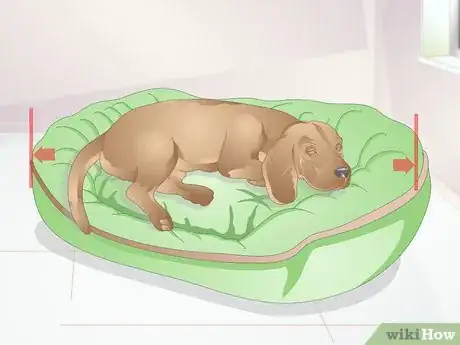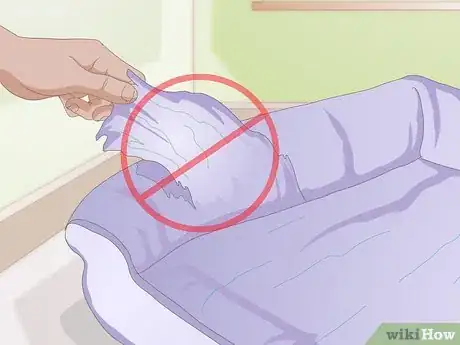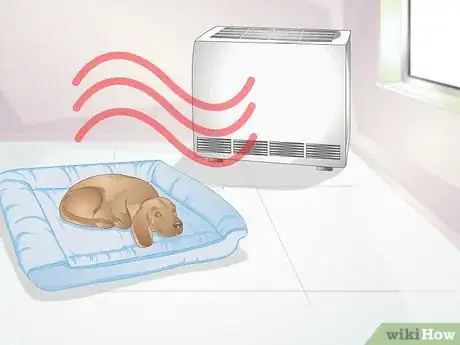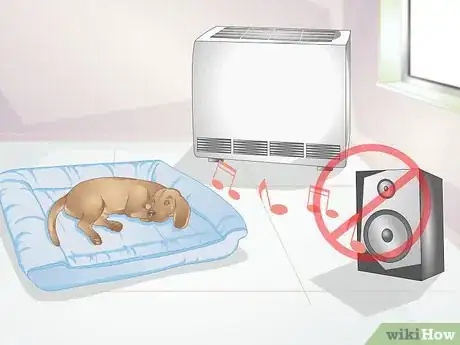This article was co-authored by Deanne Pawlisch, CVT, MA. Deanne Pawlisch is a Certified Veterinary Technician, who does corporate training for veterinary practices and has taught at the NAVTA-approved Veterinary Assistant Program at the Harper College in Illinois and in 2011 was elected to the board of the Veterinary Emergency and Critical Care Foundation. Deanne has been a Board Member of the Veterinary Emergency and Critical Care Foundation in San Antonio, Texas since 2011. She holds a BS in Anthropology from Loyola University and an MA in Anthropology from Northern Illinois University.
This article has been viewed 25,226 times.
Choosing a place for your dog to sleep is an important part of being a pet owner. A dog should have a comfortable, supportive bed or crate pad that allows them to completely stretch out. Once you get your dog a bed, it’s important to place it in a set sleeping space. This will provide consistency for your dog.
Steps
Choosing a Bed for Your Dog
-
1Think about the benefits of a dog bed. Buying a bed for your dog to sleep in has multiple benefits. A bed provides much needed cushion and insulation for your pet. A dog bed also controls odors and hair, keeping both at bay by providing a centralized and personal space for your dog to rest. A dog bed can also discourage your dog from curling up on the couch or other off-limits furniture.
-
2Consider a crate. While not everyone will choose to crate their dog, there are substantial benefits to providing your dog with a crate. A crate provides your dog with a safe place to sleep. It is a place your dog will feel comfortable, find solitude, and can rest safely. A crate is also a secure place for your dog to rest or sleep while you are out of the house or asleep.[1]Advertisement
-
3Choose the right size. Whether your dog will sleep on a bed or in a crate, it is important that his bed, crate, or pad is the appropriate size. Your dog should be able to stretch out completely on their bed, as it is necessary that the bed support them while they are in any position. Try choosing a bed, crate, or pad that is at least 5 inches longer and wider than the dog itself.
-
4Think about where your dog will be sleeping. When you buy a bed or crate pad for your dog, you should consider exactly where the dog will be sleeping. For example, if your dog sleeps on a hard floor, you should purchase a bed or pad that is soft and well-cushioned. Also make sure that any bed or pad you purchase is resistant to mold, moisture, and fungus. These environmental hazards can cause health concerns for your dog if present on its bed.
- Keep in mind that it is inhumane to leave a dog outside overnight. He will be exposed to the elements, as well as to other hazards such as wild animals and dog thieves.
-
5Consider cleanup. When choosing a bed or crate pad for your dog, you should think about how easy it will be to clean. Think about how difficult it will be to remove hair from the bed or pad, as well as how easy it will be to clean up accidents your dog might have. When possible, choose a bed or crate pad with a water-resistant cover that will make cleanup a breeze.[2]
- Look for a bed or pad that you can toss into the washing machine.
-
6Don’t skimp on quality. It is important that you consider the quality of the bed or pad you purchase for your pooch. Cheaper quality beds and pads tend to not be as supportive as their higher quality counterparts. You should also consider your dog’s bed as a long-term investment. While you might pay more now for a higher quality bed, chances are you will not be replacing it as often as you would if you buy a bed of inferior quality.
Deciding Where Your Dog Will Sleep
-
1Establish a set sleeping space. Regardless of where you decide your dog will sleep, it is important that you establish a set place for sleeping. Once you decide on a space, place your dog’s crate or bed in it. You should keep the space consistent and avoid changing the location of your dog’s sleeping space unless it is necessary.
- Do not make your dog sleep outside! It is inhumane for a number of reasons. Dogs are social animals and isolating them away from humans is cruel. Keeping a dog outside will also expose him to temperature extremes such as cold and heat, rain and snow, and other threats such as wild animals and dog thieves.
-
2Consider placing your dog’s bed in your bedroom. This is a great option for pet owners who want to be close to their dogs, but aren’t keen on sharing a bed with them. Place your dog’s bed or crate in your bedroom, perhaps near the foot of your bed or beside your bed. This will help both you and the dog get a good night’s sleep.
-
3Choose a warm place. While humans have the luxury of piling on extra blankets if they get cold while sleeping, your dog does not. For this reason, it is important to place your dog’s bed, pad, or crate in a warm place. This will allow your dog to sleep comfortably and potentially avoid nighttime antics generated from an inability to sleep.[3]
-
4Choose a quiet spot. This is especially important for puppies or older dogs that bark when they encounter distractions like noises. Place your dog’s bed, pad, or crate in a quiet spot in the house that will be free from distractions. This will help your dog get a good night’s sleep, and prevent your dog from interrupting your sleep when it is distracted.[4]
Considering Your Family’s Circumstances
-
1Think about your children. If you have kids, you will need to consider where they sleep before you choose a spot for your dog. For example, if your kids are light sleepers or you have a baby, you might not want to place the dog’s bed or crate near their rooms. Instead, choose a place for your dog to sleep that is far away from your sleeping children.[5]
- For example, a family with a baby might choose to have its dog sleep crated in a room far away from the child, such as the kitchen, to prevent the pet from potentially waking the baby.
-
2Consider the benefits of a watchdog. When deciding on a place for your dog to sleep, you should consider whether or not you want your dog to watch over and protect your home at night. For example, placing your dog’s bed near the front door might add an extra layer of protection should a stranger show up in the middle of the night.
- A family who wants the dog to watch over the house might allow the dog to sleep outside of its crate to guard the home.
-
3Think about sharing your bed. While many pet owners decide to share their bed with their dog, it is important to consider the risks of doing so. Sleeping with your dog can increase the risk of transmitting disease, and puppies with aggression issues can more fully develop these behaviors if allowed to share a bed with humans. Dogs can also transmit bacteria, fleas, and other parasites to humans if allowed to sleep in their owners’ beds.[6]
- Despite the risks, it is up to you whether or not you want to share your bed with your dog.
References
- ↑ http://www.humanesociety.org/animals/dogs/tips/crate_training.html
- ↑ http://mysweetpuppy.net/indestructible-dog-beds-reviews/
- ↑ http://www.petplace.com/article/dogs/behavior-training/bonding-with-dogs/where-should-your-dog-sleep
- ↑ https://www.overstock.com/guides/best-places-in-your-home-for-a-dog-bed
- ↑ http://www.aspca.org/pet-care/dog-care/dogs-and-babies
- ↑ http://www.petmd.com/dog/care/is-it-safe-to-sleep-with-pets
About This Article
To choose a place for your dog to sleep, start by getting a soft, comfortable dog bed that's long enough for your dog to stretch out on. Alternatively, you can get a crate for your dog and put bedding inside of it so your dog has a cozy den to sleep in. Either way, place your dog's bed in a warm, quiet place so it sleeps comfortably through the night. If you want to be close to your dog while you sleep, consider putting its bed in a corner of your bedroom or at the foot of your bed. Or, if you want your dog to be a watchdog that protects your home, place its bed near the front door. For tips from our Veterinary co-author, like how to decide if you should let your dog sleep in bed with you, keep reading!








































































